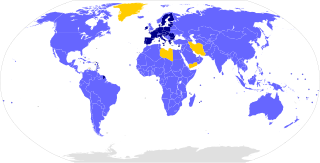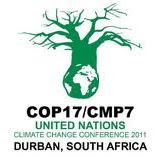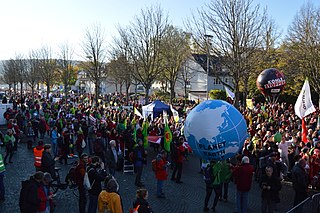Related Research Articles

The Convention on Biological Diversity (CBD), known informally as the Biodiversity Convention, is a multilateral treaty. The Convention has three main goals: the conservation of biological diversity ; the sustainable use of its components; and the fair and equitable sharing of benefits arising from genetic resources. Its objective is to develop national strategies for the conservation and sustainable use of biological diversity, and it is often seen as the key document regarding sustainable development.

The Kyoto Protocol (Japanese: 京都議定書, Hepburn: Kyōto Giteisho) was an international treaty which extended the 1992 United Nations Framework Convention on Climate Change (UNFCCC) that commits state parties to reduce greenhouse gas emissions, based on the scientific consensus that global warming is occurring and that human-made CO2 emissions are driving it. The Kyoto Protocol was adopted in Kyoto, Japan, on 11 December 1997 and entered into force on 16 February 2005. There were 192 parties (Canada withdrew from the protocol, effective December 2012) to the Protocol in 2020.

The United Nations Framework Convention on Climate Change (UNFCCC) is the UN process for negotiating an agreement to limit dangerous climate change. It is an international treaty among countries to combat "dangerous human interference with the climate system". The main way to do this is limiting the increase in greenhouse gases in the atmosphere. It was signed in 1992 by 154 states at the United Nations Conference on Environment and Development (UNCED), informally known as the Earth Summit, held in Rio de Janeiro. The treaty entered into force on 21 March 1994. "UNFCCC" is also the name of the Secretariat charged with supporting the operation of the convention, with offices on the UN Campus in Bonn, Germany.
The Copenhagen Accord is a document which delegates at the 15th session of the Conference of Parties to the United Nations Framework Convention on Climate Change agreed to "take note of" at the final plenary on 18 December 2009.

The 2010 United Nations Climate Change Conference was held in Cancún, Mexico, from 29 November to 10 December 2010. The conference is officially referred to as the 16th session of the Conference of the Parties (COP 16) to the United Nations Framework Convention on Climate Change (UNFCCC) and the 6th session of the Conference of the Parties serving as the meeting of the Parties (CMP 6) to the Kyoto Protocol. In addition, the two permanent subsidiary bodies of the UNFCCC — the Subsidiary Body for Scientific and Technological Advice (SBSTA) and the Subsidiary Body for Implementation (SBI) — held their 33rd sessions. The 2009 United Nations Climate Change Conference extended the mandates of the two temporary subsidiary bodies, the Ad Hoc Working Group on Further Commitments for Annex I Parties under the Kyoto Protocol (AWG-KP) and the Ad Hoc Working Group on Long-term Cooperative Action under the Convention (AWG-LCA), and they met as well.

The Paris Agreement is an international treaty on climate change that was adopted in 2015. The treaty covers climate change mitigation, adaptation, and finance. The Paris Agreement was negotiated by 196 parties at the 2015 United Nations Climate Change Conference near Paris, France. As of February 2023, 195 members of the United Nations Framework Convention on Climate Change (UNFCCC) are parties to the agreement. Of the three UNFCCC member states which have not ratified the agreement, the only major emitter is Iran. The United States withdrew from the agreement in 2020, but rejoined in 2021.

The 2011 United Nations Climate Change Conference (COP17) was held in Durban, South Africa, from 28 November to 11 December 2011 to establish a new treaty to limit carbon emissions.

The 2015 United Nations Climate Change Conference, COP 21 or CMP 11 was held in Paris, France, from 30 November to 12 December 2015. It was the 21st yearly session of the Conference of the Parties (COP) to the 1992 United Nations Framework Convention on Climate Change (UNFCCC) and the 11th session of the Meeting of the Parties (CMP) to the 1997 Kyoto Protocol.

The nationally determined contributions (NDCs) are commitments that countries make to reduce their greenhouse gas emissions as part of climate change mitigation. These commitments include the necessary policies and measures for achieving the global targets set out in the Paris Agreement. The Paris Agreement has a long-term temperature goal which is to keep the rise in global surface temperature to well below 2 °C (3.6 °F) above pre-industrial levels. The treaty also states that preferably the limit of the increase should only be 1.5 °C (2.7 °F). To achieve this temperature goal, greenhouse gas emissions should be reduced as soon as, and by as much as, possible. To stay below 1.5 °C of global warming, emissions need to be cut by roughly 50% by 2030. This figure takes into account each country's documented pledges or NDCs.

The 2016 United Nations Climate Change Conference was an international meeting of political leaders and activists to discuss environmental issues. It was held in Marrakech, Morocco, on 7–18 November 2016. The conference incorporated the twenty-second Conference of the Parties (COP22), the twelfth meeting of the parties to the Kyoto Protocol (CMP12), and the first meeting of the parties to the Paris Agreement (CMA1). The purpose of the conference was to discuss and implement plans about combatting climate change and to "[demonstrate] to the world that the implementation of the Paris Agreement is underway". Participants work together to come up with global solutions to climate change.

The 2017 United Nations Climate Change Conference (COP23) was an international meeting of political leaders, non-state actors and activists to discuss environmental issues. It was held at UN Campus in Bonn, Germany, during 6–17 November 2017. The conference incorporated the 23rd Conference of the Parties to the United Nations Framework Convention on Climate Change (UNFCCC), the thirteenth meeting of the parties for the Kyoto Protocol (CMP13), and the second session of the first meeting of the parties for the Paris Agreement.
Article 6 of the Paris Agreement on climate change enables Parties to cooperate in implementing their nationally determined contributions (NDCs). Among other things, this means that emission reductions can be transferred between countries and counted towards NDCs. Agreement on the provisions of Article 6 was reached after intensive negotiations lasting several years.
The Talanoa Dialogue was a 2017–2018 process within climate change discussions, designed to help countries implement and enhance their Nationally Determined Contributions by 2020. The Dialogue was mandated by the Parties to the United Nations Framework Convention on Climate Change to take stock of the collective global efforts to reduce the emissions of greenhouse gases, in line with the goals of the Paris Agreement, which is to limit the rise in average global temperature to 2°C (3.6°F) above pre-industrial levels, and to pursue efforts to limit the increase to 1.5°C (2.7°F).
The Global Stocktake is a fundamental component of the Paris Agreement which is used to monitor its implementation and evaluate the collective progress made in achieving the agreed goals. The Global Stocktake thus links implementation of nationally determined contributions (NDCs) with the overarching goals of the Paris Agreement, and has the ultimate aim of raising climate ambition.

Sustainable Development Goal 13 is to limit and adapt to climate change. It is one of 17 Sustainable Development Goals established by the United Nations General Assembly in 2015. The official mission statement of this goal is to "Take urgent action to combat climate change and its impacts". SDG 13 and SDG 7 on clean energy are closely related and complementary.
The Task Force on Climate Related Financial Disclosures (TCFD) provides information to investors about what companies are doing to mitigate the risks of climate change, as well as be transparent about the way in which they are governed. It was established in December 2015 by the Group of 20 (G20) and the Financial Stability Board (FSB), and is chaired by Michael Bloomberg. It consists of governance, strategy, risk management, and metrics and targets. It will become mandatory for companies to report on these disclosures by 2025 in the UK, although some companies will have to report earlier.
Climate TRACE is an independent group which monitors and publishes greenhouse gas emissions. It launched in 2021 before COP26, and improves monitoring, reporting and verification (MRV) of both carbon dioxide and methane. The group monitors sources such as coal mines and power station smokestacks worldwide, with satellite data and artificial intelligence.

Pledge and review is a method for facilitating international action against climate change. It involves nations each making a self-determined pledge relating to actions they expect to take in response to global warming, which they submit to the United Nations. Some time after the pledges have been submitted, there is a review process where nations assess each other's progress towards meeting the pledges. Then a further round of enhanced pledges can be made, and the process can further iterate.

REDD+ is a framework to encourage developing countries to reduce emissions and enhance removals of greenhouse gases through a variety of forest management options, and to provide technical and financial support for these efforts. The acronym refers to "reducing emissions from deforestation and forest degradation in developing countries, and the role of conservation, sustainable management of forests, and enhancement of forest carbon stocks in developing countries". REDD+ is a voluntary climate change mitigation framework developed by the United Nations Framework Convention on Climate Change (UNFCCC). REDD originally referred to "reducing emissions from deforestation in developing countries", which was the title of the original document on REDD. It was superseded by REDD+ in the Warsaw Framework on REDD-plus negotiations.
References
- ↑ "Paris Rulebook: Enhanced Transparency Framework". World Resources Institute. United States: World Resources Institute. 2019-11-21. Retrieved 2020-04-09.
- ↑ "Moving Towards the Enhanced Transparency Framework". unfccc.int. United Nations Framework Convention on Climate Change. Archived from the original on 2019-11-13. Retrieved 2020-04-09.
- ↑ "Understanding the Enhanced Transparency Framework". Climate and Development Knowledge Network. Climate and Development Knowledge Network. 2019-06-15. Retrieved 2020-04-09.
- ↑ Paris Agreement, Art. 4.3
- ↑ Paris Agreement, Art. 4.2
- ↑ Bodansky, D. (2016), "The Legal Character of the Paris Agreement.", Review of European, Comparative & International Environmental Law, 25 (2), pp. 142-150, doi:10.1111/reel.12154
- ↑ Paris Agreement, Art. 14.
- ↑ Paris Agreement, Art. 13.2.
- ↑ Obergassel, W.; Arens, C.; Hermwille, L.; Kreibich, N.; Ott, H. & Wang-Helmreich, H. (2019), "Paris Agreement: Ship Moves Out of the Drydock.", Carbon and Climate Law Review, 13 (01), pp. 3-18, doi:10.21552/cclr/2019/1/4CS1
- ↑ Decision 18/CMA.1, Annex, Abs. 104.
- ↑ Decision 18/CMA.1, Annex, Abs. 118, 130
- ↑ Decision 18/CMA.1, Annex, Abs. 77 (d)
- ↑ Deutsche Gesellschaft für internationale Zusammenarbeit (GIZ) (2019), Next steps under the Paris Agreement and the Katowice Climate Package